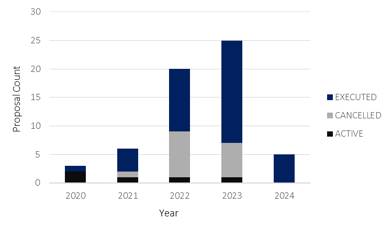The emergence of smart contracts has fostered the rise of decentralised applications (dApps) built on top of public blockchains. In essence, this milestone in the evolution of blockchain technology opened up an unprecedented avenue for the development of applications that possess an inherent resistance to censorship and run automatically when certain predefined conditions are satisfied.
However, the initial enthusiasm was soon tempered by the recognition of certain limitations, as smart contracts encountered substantial challenges within the infrastructure that powered them. Scalability and sovereignty swiftly emerged as significant obstacles for decentralised applications, which demanded innovative solutions.
In this context, the Cosmos ecosystem was conceived to address the aforementioned blockchain constraints and provide an interoperable environment to promote an “internet of blockchains”. With this intention at the forefront, Cosmos was designed as a framework that aims at furnishing the appropriate set of tools to create interconnected, scalable and sovereign blockchains.
What is the Cosmos Ecosystem?
Cosmos is a decentralised network of autonomous, scalable and interconnected blockchains, which currently hosts around 50 chains and more than 240 apps and services. Conceived as a framework to facilitate blockchain scalability and interoperability, Cosmos is often labelled as a Layer 0 blockchain, due to its provision of essential tools for the establishment of Layer 1 blockchains.
These Layer 1 blockchain are commonly referred to as application chains within the Cosmos Ecosystem. Consequently, application chains can be defined as customizable solutions tailored to address specific challenges.
Cosmos Architecture
The Cosmos ecosystem, driven by its objective to foster the internet of blockchains, incentivises the proliferation of application chains within its ecosystem. To support this vision, Cosmos offers an array of open-source resources that empower developers in their pursuit of blockchain innovation.
Overall, the Cosmos architecture encompasses:
- Cosmos SDK. The Cosmos SDK stands as a pivotal component of the Cosmos architecture, providing developers with a versatile framework, endowed with composable modules, to facilitate the development of customizable application chains swiftly and efficiently.
- Tendermint Consensus. Tendermint consists of a Byzantine Fault-Tolerance consensus algorithm, that empowers applications to achieve synchronised replication across multiple machines. Tendermint consensus is achieved when at least two-thirds of actives nodes operate reliably and consistently, without encountering unexpected or unpredictable failures. Furthermore, it offers instant finality, eliminating the need for transaction confirmation before considering it valid once it has been included in a block and added to the chain. Currently, Tendermint serves as one of the most widely adopted BFT consensus engines for Proof of Stake (PoS) blockchains.
- Inter-Blockchain Communication Protocol (IBC). The IBC is a protocol that enables seamless and secure communication between diverse blockchains. It consists of two distinct layers, a transport layer with the infrastructure to establish secure connections and data packet authentication, and the application layer, employed to define how data packets should be packaged and interpreted by the involved chains. The IBC application layer offers a resourceful framework for developing an extensive array of cross-chain applications, including without being exhaustive, fungible token and non-fungible token transfers and Oracle data feeds integrations.
- CosmWasm is designed to provide developers with a secure and efficient environment for creating, testing, and executing smart contracts. With the aim of harnessing the speed of WebAssembly and the robustness of Rust, CosmWasm was developed as a module to be plugged into the Cosmos SDK. In light of this strategic approach, decentralized applications crafted with CosmWasm are chain agnostic.
How does Cosmos Address Blockchain Constraints?
The establishment of the Cosmos ecosystem aims to maximize the potential of blockchain technology by enhancing its scalability, sovereignty and interoperability. The first issue is effectively tackled thanks to the development of an optimized consensus mechanism, such as Tendermint. This mechanism allows blockchains to enhance nodes’ participation in the state replication, consensus observation, and any activity that queries the state. Furthermore, by employing a multi-chain architecture decentralised applications can run concurrently on different chains coordinated by the IBC protocol, fostering their scalability.
In terms of sovereignty, traditional blockchains offer two layer-governance structures, where decisions rely on the governance of specific applications built on top of the blockchain and the governance mechanisms of the blockchain itself. In contrast, Cosmos enables developers to create dedicated blockchains tailored to their specific applications. Each application chain operates with its own set of validators, fostering governance autonomy for their applications.
As it was aforementioned, the IBC protocol facilitates the interoperability of application chains within the Cosmos Ecosystem. However, the IBC interoperability feature is not limited to Cosmos blockchains. If a non-Tendermint blockchain uses a fast-finality consensus algorithm, a connection can be established by enabling the IBC protocol to work with the non-Tendermint consensus mechanism.
Moreover, the modular design of the Cosmos SDK enables integrations of existing codebases, allowing seamless compatibility. An excellent example is Etheremint, a software designed to port the Ethereum Virtual Machine (EVM) as a Cosmos SDK module. This powerful tool equips developers with the capability to build application chains fully compatible with Ethereum and the Cosmos SDK as well. With the aid of these resources, Cosmos improves the interoperability of the whole blockchain landscape.
The Interchain Foundation
Cosmos was co-founded by Jae Kwon and Ethan Buchman in 2014, while its whitepaper was published in 2016. During this time, they spearheaded the development of the Tendermint consensus. Lately, in 2017, Buchman and Kwon established and led the Interchain Foundation to fund, stewards and further develop the Cosmos Ecosystem.
Cosmos was officially launched in 2019, and in March of the same year, the IBC protocol was activated, enabling seamless interoperability. Beyond the Interchain Foundation, Cosmos prides itself on fostering an actively engaged community, where individual developers, creators and users collaboratively work towards realizing their collective vision of an interconnected, highly scalable and sovereign blockchain ecosystem.
Topic
Crypto industry

